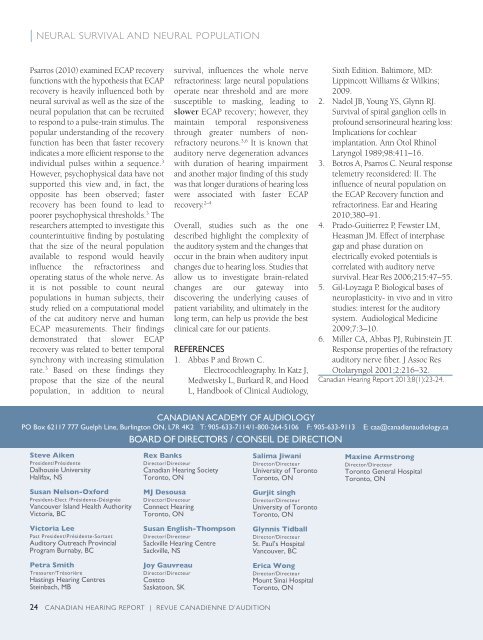Volume 8 Issue 1 (pdf) - Andrew John Publishing Inc
Volume 8 Issue 1 (pdf) - Andrew John Publishing Inc
Volume 8 Issue 1 (pdf) - Andrew John Publishing Inc
Create successful ePaper yourself
Turn your PDF publications into a flip-book with our unique Google optimized e-Paper software.
|<br />
Psarros (2010) examined ECAP recovery<br />
functions with the hypothesis that ECAP<br />
recovery is heavily influenced both by<br />
neural survival as well as the size of the<br />
neural population that can be recruited<br />
to respond to a pulse-train stimulus. The<br />
popular understanding of the recovery<br />
function has been that faster recovery<br />
indicates a more efficient response to the<br />
individual pulses within a sequence. 3<br />
However, psychophysical data have not<br />
supported this view and, in fact, the<br />
opposite has been observed; faster<br />
recovery has been found to lead to<br />
poorer psychophysical thresholds. 3 The<br />
researchers attempted to investigate this<br />
counterintuitive finding by postulating<br />
that the size of the neural population<br />
available to respond would heavily<br />
influence the refractoriness and<br />
operating status of the whole nerve. As<br />
it is not possible to count neural<br />
populations in human subjects, their<br />
study relied on a computational model<br />
of the cat auditory nerve and human<br />
ECAP measurements. Their findings<br />
demonstrated that slower ECAP<br />
recovery was related to better temporal<br />
synchrony with increasing stimulation<br />
rate. 3 Based on these findings they<br />
propose that the size of the neural<br />
population, in addition to neural<br />
survival, influences the whole nerve<br />
refractoriness: large neural populations<br />
operate near threshold and are more<br />
susceptible to masking, leading to<br />
slower ECAP recovery; however, they<br />
maintain temporal responsiveness<br />
through greater numbers of nonrefractory<br />
neurons. 3,6 It is known that<br />
auditory nerve degeneration advances<br />
with duration of hearing impairment<br />
and another major finding of this study<br />
was that longer durations of hearing loss<br />
were associated with faster ECAP<br />
recovery. 2–4<br />
Overall, studies such as the one<br />
described highlight the complexity of<br />
the auditory system and the changes that<br />
occur in the brain when auditory input<br />
changes due to hearing loss. Studies that<br />
allow us to investigate brain-related<br />
changes are our gateway into<br />
discovering the underlying causes of<br />
patient variability, and ultimately in the<br />
long term, can help us provide the best<br />
clinical care for our patients.<br />
referenCes<br />
1. Abbas P and Brown C.<br />
Electrocochleography. In Katz J,<br />
Medwetsky L, Burkard R, and Hood<br />
L, Handbook of Clinical Audiology,<br />
Sixth Edition. Baltimore, MD:<br />
Lippincott Williams & Wilkins;<br />
2009.<br />
2. Nadol JB, Young YS, Glynn RJ.<br />
Survival of spiral ganglion cells in<br />
profound sensorineural hearing loss:<br />
Implications for cochlear<br />
implantation. Ann Otol Rhinol<br />
Laryngol 1989;98:411–16.<br />
3. Botros A, Psarros C. Neural response<br />
telemetry reconsidered: II. The<br />
influence of neural population on<br />
the ECAP Recovery function and<br />
refractoriness. Ear and Hearing<br />
2010;380–91.<br />
4. Prado-Guitierrez P, Fewster LM,<br />
Heasman JM. Effect of interphase<br />
gap and phase duration on<br />
electrically evoked potentials is<br />
correlated with auditory nerve<br />
survival. Hear Res 2006;215:47–55.<br />
5. Gil-Loyzaga P. Biological bases of<br />
neuroplasticity- in vivo and in vitro<br />
studies: interest for the auditory<br />
system. Audiological Medicine<br />
2009;7:3–10.<br />
6. Miller CA, Abbas PJ, Rubinstein JT.<br />
Response properties of the refractory<br />
auditory nerve fiber. J Assoc Res<br />
Otolaryngol 2001;2:216–32.<br />
Canadian Hearing Report 2013;8(1):23-24.<br />
CANADIAN ACADEMY OF AUDIOLOGY<br />
PO Box 62117 777 Guelph Line, Burlington ON, L7R 4K2 T: 905-633-7114/1-800-264-5106 F: 905-633-9113 E: caa@canadianaudiology.ca<br />
BOARDOFDIRECTORS / CONSEIL DE DIRECTION<br />
Steve Aiken<br />
President/Présidente<br />
Dalhousie University<br />
Halifax, NS<br />
Rex Banks<br />
Director/Directeur<br />
Canadian Hearing Society<br />
Toronto, ON<br />
Salima Jiwani<br />
Director/Directeur<br />
University of Toronto<br />
Toronto, ON<br />
Maxine Armstrong<br />
Director/Directeur<br />
Toronto General Hospital<br />
Toronto, ON<br />
Susan Nelson-Oxford<br />
President-Elect /Présidente-Désignée<br />
Vancouver Island Health Authority<br />
Victoria, BC<br />
MJ Desousa<br />
Director/Directeur<br />
Connect Hearing<br />
Toronto, ON<br />
Gurjit singh<br />
Director/Directeur<br />
University of Toronto<br />
Toronto, ON<br />
Victoria Lee<br />
Past President/Présidente-Sortant<br />
Auditory Outreach Provincial<br />
Program Burnaby, BC<br />
Susan English-Thompson<br />
Director/Directeur<br />
Sackville Hearing Centre<br />
Sackville, NS<br />
Glynnis Tidball<br />
Director/Directeur<br />
St. Paul’s Hospital<br />
Vancouver, BC<br />
Petra Smith<br />
Treasurer/Trésorière<br />
Hastings Hearing Centres<br />
Steinbach, MB<br />
Joy Gauvreau<br />
Director/Directeur<br />
Costco<br />
Saskatoon, SK<br />
Erica Wong<br />
Director/Directeur<br />
Mount Sinai Hospital<br />
Toronto, ON<br />
24 CANADIAN HEARING REPORT | REVUE CANADIENNE D’AUDITION






